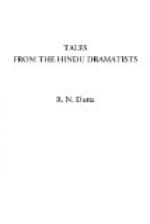The play thus opened, is carried forward in scenes and acts; each scene being marked by the entrance of one character and the exit of another. The stage is never left vacant till the end of an act, nor does any change of locality take place till then. The commencement of a new act is often marked, by an introductory monologue or dialogue spoken by one or more of the dramatis personae, and is called Viskambhaka or Praveshaka, which alludes to events supposed to have occurred in the interval, and the audience are prepared for national plenty and prosperity, addressed by one of the principal personages of the drama, to the favourite deity. The development of the plot is brought about through five divisions called the five sandhis. A sandhi is a combination of incidents whereby the object is attained.
THE MANNER OF PERFORMANCE.
There were no special theatres in the Hindu Middle Ages, and plays seem to have been performed in the concert-room (Sangita-Cala) of royal palaces. A curtain, divided in the middle, was a necessary part of the stage arrangement; it did not, however, separate the audience from the stage, as in the Roman theatre, but formed the back-ground of the stage. Behind the curtain was the tiring-room (nepathya), whence the actors came on the stage. When they were intended to enter hurriedly, they were directed to do so “with a toss of the curtain.” The stage scenery and decorations were of a very simple order, much being left to the imagination of the spectator, as in the Shakespearian drama. Weapons, seats, thrones, and chariots appeared on the stage; but it is highly improbable that the latter were drawn by the living animals supposed to be attached to them. There may have been some kind of aerial contrivance to represent celestial chariots.
KALIDASA.
Kalidasa is the author of Sakuntala, Vikramorvasi and Malavikagnimitra. He has been designated the Indian Shakespeare. He is reputed to have been one of the nine ornaments (or “gems”) of the Court of Vikramaditya, king of Ujayin, whose Era, called Samvat, begins in 56 B.C. Stories extant about him describe him to be the veriest fool. He rose to be a great poet through the favour of the Goddess of Learning. Those stories embody the public opinion that except through Divine Grace or the Inspiration of the Muse a man cannot rise to such eminence by learning and culture alone. His native place is Kashmir or its neighbourhood. He had no doubt suffered from the pangs of poverty and neglect and travelled a great deal. He professed the Saiva form of worship.




